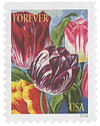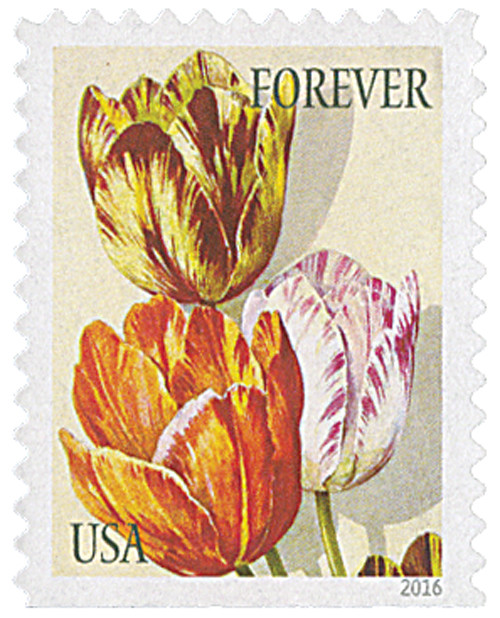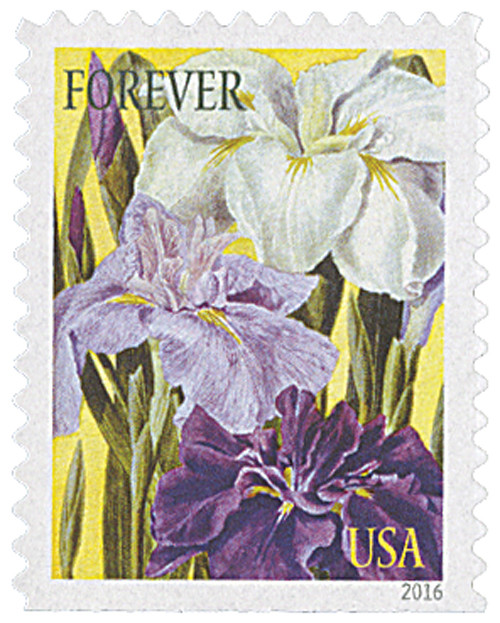
# 5043 - 2016 First-Class Forever Stamp - Botanical Art: Red, Purple and Pink Tulips
US #5043
2016 Tulips – Botanical Art
- Celebrates botanical artwork in American nursery catalogs printed between 1891 and 1912
Stamp Category: Definitive
Set: Botanical Art
Value: 49¢ First Class Mail Rate (Forever)
First Day of Issue: January 29, 2016
First Day City: Atlanta, Georgia
Quantity Issued: 60,000,000
Printed by: Ashton Potter
Printing Method: Offset
Format: Booklets of 10 OR Double-sided booklets of 20
Tagging: Nonphosphored type III, block tag applied
Why the stamp was issued: To continue the tradition of printing floral-themed US stamps.
About the stamp design: Pictures tulips from an American nursery catalog printed between 1891 and 1912. The catalog was from The New York Botanical Garden’s Nursery and Seed Catalog Collection.
First Day City: The First Day of Issue Ceremony was held at the American Philatelic Society’s AmeriStamp/Southeastern Stamp Expo. at the Hilton Atlanta in Atlanta, Georgia.
About the Botanical Art set: 10 stamps all picturing different artwork from a 100+ year old American nursery catalog. Species pictured include: corn lilies, tulips, dahlias, stocks, roses, Japanese irises, petunias, and jonquils.
History the stamp represents: Hundreds of years before the first bulb reached Holland, gardeners from the ancient Ottoman Empire were cultivating tulips. Early drawings of these exotic flowers fueled interest in them across Europe.
During the mid-1500s, an ambassador to the court in Constantinople gave a Dutch botanist a gift of rare tulip bulbs. This exchange set a series of events known as “Tulipomania” into motion.
When word got out that the botanist had planted the rare bulbs in Holland, thieves stole them from his garden. Though more were cultivated, demand for the rare tulips grew sharply across Europe. An active market developed and prices rose accordingly. By 1624, a single bulb similar to the modern “Rembrandt” variety sold for the equivalent of $1,500. Another buyer paid $2,250 plus a horse and carriage for one bulb. In France, wealthy women tucked tulips into their undergarments as symbols of desirability.
Tulipomania was the first real “economic bubble,” and it burst in 1637. Rich traders became bankrupt overnight as prices settled at a realistic level. Today, the Dutch lead in tulip production, exporting over seven billion bulbs each year. The largest importer is the United States, which spends roughly $130 million annually on tulip bulbs.
US #5043
2016 Tulips – Botanical Art
- Celebrates botanical artwork in American nursery catalogs printed between 1891 and 1912
Stamp Category: Definitive
Set: Botanical Art
Value: 49¢ First Class Mail Rate (Forever)
First Day of Issue: January 29, 2016
First Day City: Atlanta, Georgia
Quantity Issued: 60,000,000
Printed by: Ashton Potter
Printing Method: Offset
Format: Booklets of 10 OR Double-sided booklets of 20
Tagging: Nonphosphored type III, block tag applied
Why the stamp was issued: To continue the tradition of printing floral-themed US stamps.
About the stamp design: Pictures tulips from an American nursery catalog printed between 1891 and 1912. The catalog was from The New York Botanical Garden’s Nursery and Seed Catalog Collection.
First Day City: The First Day of Issue Ceremony was held at the American Philatelic Society’s AmeriStamp/Southeastern Stamp Expo. at the Hilton Atlanta in Atlanta, Georgia.
About the Botanical Art set: 10 stamps all picturing different artwork from a 100+ year old American nursery catalog. Species pictured include: corn lilies, tulips, dahlias, stocks, roses, Japanese irises, petunias, and jonquils.
History the stamp represents: Hundreds of years before the first bulb reached Holland, gardeners from the ancient Ottoman Empire were cultivating tulips. Early drawings of these exotic flowers fueled interest in them across Europe.
During the mid-1500s, an ambassador to the court in Constantinople gave a Dutch botanist a gift of rare tulip bulbs. This exchange set a series of events known as “Tulipomania” into motion.
When word got out that the botanist had planted the rare bulbs in Holland, thieves stole them from his garden. Though more were cultivated, demand for the rare tulips grew sharply across Europe. An active market developed and prices rose accordingly. By 1624, a single bulb similar to the modern “Rembrandt” variety sold for the equivalent of $1,500. Another buyer paid $2,250 plus a horse and carriage for one bulb. In France, wealthy women tucked tulips into their undergarments as symbols of desirability.
Tulipomania was the first real “economic bubble,” and it burst in 1637. Rich traders became bankrupt overnight as prices settled at a realistic level. Today, the Dutch lead in tulip production, exporting over seven billion bulbs each year. The largest importer is the United States, which spends roughly $130 million annually on tulip bulbs.















